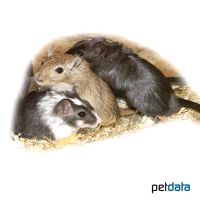Mixed Gerbil (Meriones unguiculatus 'Mixed')
| Mixed Gerbil Meriones unguiculatus 'Mixed' | |
|---|---|
| Name | Mixed Gerbil |
| Name Lat. | Meriones unguiculatus 'Mixed' |
| Synonym | Gerbil Mixed |
| Family | Murids |
| Family lat. | Muridae |
| Order | Rodents |
| Order lat. | Rodentia |
| Origin | Asia (breeding variety) |
| Climate | Temperate |
| Habitat | Steppe, semi-desert |
| Diet | Gerbil food, herbs, hay, insects |
| Behavior | Diurnal, nocturnal |
| Keeping | Pair, group |
| Care Level | Easy |
| Life Span | 3-4 years |
| Protection | No |
| Metric Units | |
| Size | 10-14 cm |
| Temperature | Room temperature |
| Housing | A: 0.5 m² / H: 50-60 cm |
| US Units | |
| Size | 3.9"-5.5" |
| Temperature | Room temperature |
| Housing | 5 ft² / 20" hight |
Distribution and habitat
The Mongolian gerbil Mixed is a color variety of the Mongolian gerbils. They inhabit the steppes and semi-deserts of Mongolia and northern China. There they live in widely ramified underground tunnel systems. All Mongolian gerbils available today are descended from about 15 breeding pairs caught in eastern Mongolia around 1935.
Maintenance
Minimum dimensions for the enclosure:
| 1-2 animals | area: 0,5 m² | height: 50-60 cm |
| Each additional animal | Area: + 20 |
A terrarium placed in a bright (no direct sunlight), draught-free and quiet place is recommended, with ventilation openings on the sides, and it must not be tightly closed at the top. The enclosure should be structured with rocks, roots, and branches, and provide hiding and shelter (rodent houses, tubes, clay caves, etc.). They need food and drinking containers (drinking bottles), a sand bath (chinchilla sand) for grooming, nesting material (hay, straw, etc.) and a graveable substrate of commercial small animal litter or a sand-soil mixture covered with some bark mulch and dry leaves. The bedding depth should be at least 10 cm, better 20 cm. Nail material, such as untreated twigs and branches of fruit trees, as well as a rodent stone, must always be available to wear down their teeth. They should be kept at room temperature and their natural day-night rhythm should be respected.
Diet
Their diet is mainly vegetarian, but they also need animal protein. The diet consists of a low-fat grain mixture, available from specialist retailers as "gerbil food", supplemented with forage hay, foxtail millet, green fodder (root vegetables, wild herbs, zucchini, etc.) and a mineral stone. In addition, they need animal protein several times a week, such as live insects (crickets, house crickets, mealybug larvae), cottage cheese, a hard-boiled hen's egg or insect food for hedgehogs. Fruit must be offered only rarely and in very small quantities (risk of diabetes). Drinking water must always be available in hanging bottles or in stable, open containers and, like food, must be offered fresh daily
A varied diet promotes health and prevents deficiency symptoms.
Behaviour and compatibility
They are social animals and should be kept in pairs or in a group (1 male, 2-5 females) with sufficient retreat possibilities. In larger groups there are often fierce territorial fights. It is recommended to keep them in family groups or same-sex groups. At the first signs of incompatibility, the animals must be separated immediately
Reproduction and breeding
Testes can be clearly seen in sexually mature males, and the distance between the anus and the urethral opening is greater in juvenile males than in females.
The gestation period is between 23-26 days. The average 4-5 young are born naked, blind and deaf. After 5 days the ears open and after 2-3 week the eyes open. The young are suckled until 21 days, after which they may be separated from the mother. Females are sexually mature after 65-85 days, males after 70-85 days.
Important
Mongolian gerbils are bred today in many different color varieties
They have excellent hearing and are very sensitive to noise. They should not be fed too much, as they easily become obese. They are very lively and eager to dig. It has proved successful to cover one part of the enclosure with litter and the other part with a sand-earth mixture.
Running wheels must be injury-proof, have a closed running surface and back wall, with a diameter that the animals can run without bending their backs. As escape animals, they need sufficient retreat and hiding places, so the enclosure should also be somewhat elevated and not placed on the floor.
They should not be grabbed or pulled by the tail, as the skin can easily crack and detach. The animals should only be grasped by hand from below and lifted up. Particular attention should be paid to thorough hygiene and contamination should be removed regularly.
Further literature can be found in your pet store.
References
Text: petdata; Image: petdata
Source: W. PUSCHMANN, D. ZSCHEILE, K. ZSCHEILE (2009): Zootierhaltung - Tiere in menschlicher Obhut: Säugetiere, Harri Deutsch Verlag, BMEL (2014): Gutachten über Mindestanforderungen an die Haltung von Säugetieren
- Gemäß § 21 Abs. 5 Tierschutzgesetz idgF
